- News
- Reviews
- Bikes
- Components
- Bar tape & grips
- Bottom brackets
- Brake & gear cables
- Brake & STI levers
- Brake pads & spares
- Brakes
- Cassettes & freewheels
- Chains
- Chainsets & chainrings
- Derailleurs - front
- Derailleurs - rear
- Forks
- Gear levers & shifters
- Groupsets
- Handlebars & extensions
- Headsets
- Hubs
- Inner tubes
- Pedals
- Quick releases & skewers
- Saddles
- Seatposts
- Stems
- Wheels
- Tyres
- Tubeless valves
- Accessories
- Accessories - misc
- Computer mounts
- Bags
- Bar ends
- Bike bags & cases
- Bottle cages
- Bottles
- Cameras
- Car racks
- Child seats
- Computers
- Glasses
- GPS units
- Helmets
- Lights - front
- Lights - rear
- Lights - sets
- Locks
- Mirrors
- Mudguards
- Racks
- Pumps & CO2 inflators
- Puncture kits
- Reflectives
- Smart watches
- Stands and racks
- Trailers
- Clothing
- Health, fitness and nutrition
- Tools and workshop
- Miscellaneous
- Buyers Guides
- Features
- Forum
- Recommends
- Podcast
review
 Spa Cycles Audax Mono
Spa Cycles Audax Mono£835.00
VERDICT:
Exceptional value and performance on a bike that can unlock long-distance fixed-gear adventures
Superbly comfortable
Excellent value
Built for big distances
Saddle won’t suit all
Welding could be neater
Weight:
10,300g
Contact:

This product has been selected to feature in road.cc recommends. That means it's not just scored well, but we think it stands out as special. Go to road.cc recommends
At road.cc every product is thoroughly tested for as long as it takes to get a proper insight into how well it works. Our reviewers are experienced cyclists that we trust to be objective. While we strive to ensure that opinions expressed are backed up by facts, reviews are by their nature an informed opinion, not a definitive verdict. We don't intentionally try to break anything (except locks) but we do try to look for weak points in any design. The overall score is not just an average of the other scores: it reflects both a product's function and value – with value determined by how a product compares with items of similar spec, quality, and price.
What the road.cc scores meanGood scores are more common than bad, because fortunately good products are more common than bad.
- Exceptional
- Excellent
- Very Good
- Good
- Quite good
- Average
- Not so good
- Poor
- Bad
- Appalling
The Spa Cycles Audax Mono is built for big rides. Based on the company's well-regarded Audax frame, it is a ridiculously comfortable bike that will eat up the miles, climbs incredibly well and will keep you in control on the steepest of descents. And if you want to dip your toe into the slightly eccentric world of long-distance fixed-gear riding, then its combination of build quality and excellent value make this a great choice.
If you like your long-distance bike served up with some gearing, check out our guide to the best touring bikes.
> Buy now: Spa Cycles Audax Mono from £795 from Spa Cycles
It was 6am as we rode out of Chepstow and dropped towards the ruins of Tintern Abbey to follow the road along the River Wye. We were setting out on the Brevet Cymru, a 400km ride across Wales and back that I was hoping to finish in a little under 24 hours. Propelling me along this genteel opening section was the flywheel spin of the fixed-gear Spa Cycles Audax Mono.
It had arrived at 10am the previous day and – after some light assembly – I had just enough time for a 4km dash around the block to test it out. The consensus on my cycling WhatsApp groups was that it would be 'A Very Bad Idea' to tackle some of West Wales' steepest inclines on a bike I'd hardly ridden.
But its Mediterranean blue frame glinted enticingly, so what could I do? I loaded it up with saddle bags and hoped my legs were up to the challenge.
And as we climbed steadily towards Hay on Wye, we were treated to stunning views of blue skies and cloud inversions that clung to the base of the Black Mountains.
I had been riding a Specialized Langster fixie for almost a year. It's a great bike that flies up hills but has proved too aggressively angled for the kind of long distance riding that I love. At the end of my first fixed 400k ride to York, I was in real discomfort, but a friend on his Spa Cycles Mono was looking irritatingly fresh. Its geometry is designed for this kind of riding, and I was keen to test one out.
Its Reynolds 725 double-butted steel frame offers an excellent balance of weight and strength. It comes with a pair of handbuilt wheels (crafted and signed by Spa Cycles' own 'in-house magician' Bobby Stevens). These are laced rather than radial, and what they give up in terms of aerodynamics is more than compensated for in comfort and compliance.
You can order your bike with a steel fork but I went for the carbon option, with its promise of lighter weight and added shock absorption.
The frame allows clearance for 28mm tyres with mudguards on. And that combination of wheels, carbon and steel delivered an impressively smooth ride as we headed to the coast, ironing out some of Wales's lumpiest and least-cared-for roads.
I bumped into another Audax Mono rider who was tackling the route with loaded pannier racks. He'd ridden to the start the previous day, bivvied overnight and seemed to be carrying his full camping setup with him.
'What do you think of the bike, Dai?' I asked him.
'I bloody love it,' he replied.
With eyelets for mudguards and panniers, this is a do-everything bike that would work for winter training, all-weather commuting and just this kind of light touring.
Can you fix it?
There are two initial challenges when you start riding a fixie. The first is remembering that you can't freewheel. You will forget at some point and experience a spine-jarring jolt as the pedal continues to revolve.
The second is learning how to tackle hills – but that's far less of a problem than you might imagine. Without a derailleur, fixed-gear bikes are lighter, and you have to attack each incline, so there's no choice but to ride fast.
> What’s a fixed-gear bike good for? Should you buy a fixie?
And while you can't drop into a lower gear, you still have plenty of options. You can sit back in the saddle and push to recruit your bigger leg muscles. You can stand and use the handlebar for leverage; weave across the road to create a shallower gradient or lean over the bar and drive your knees forward as though you are running. And when the climb gets too much you can always get off and push. Think of it as your 'granny gear'.
I had to do just that as I took the Audax Mono up the steepest part of Cheddar Gorge on one ride, and I still beat my PB by almost a minute for the 3.6km climb with 153m of ascent. I did the same riding across the bruising 5km Machynlleth Mountain Road in Wales a month later and picked up another PB.
It took a while to learn how to get the best out of this bike, but when I did my climbing jumped to another level. In fact, in the two months that I've now been riding the Mono, Strava tells me I've beaten PBs on almost every hill I've ridden it up.
Hills mean that you do need to decide on your gear ratio. The team at Spa Cycles are super helpful and we decided on a 42-tooth chainring with a 16-tooth sprocket. This translates into roughly 73 gear inches (this is how far the bike moves with one full revolution of the pedals). That allowed me to get up all but the most ferocious of inclines and easily cruise at around 30kph on the flat.
And because this frame is based on a standard road bike, the bottom bracket is lower than you might normally expect on a fixie. So they also recommended a shorter crank length of 170mm, to prevent 'pedal strike' on corners. To be honest, I'm too tentative a rider for this to be a real risk, but the whole setup worked incredibly well.
What goes up...
While climbing really isn't the problem, coming back down again definitely is. You need to keep spinning your pedals, and on a long descent that can be really challenging. So you need brakes that you can trust as you hone your technique.
My Audax Mono came with Tektro R737 callipers that open wide to accommodate big tyres. Bob at Spa Cycles suggested a pair of drilled TRP-RRL brake levers that feel great when you're climbing out of the saddle and reassuringly positive when you're descending.
These levers add a modern twist to an otherwise traditional bike. They scored very well in our review from back in 2015, but they did nudge the price of the build over the £800 mark. It felt like a good investment, though, and coupled with the FSA Wing Compact handlebar, with its ergonomically flat upper, the comfort levels just kept improving as I grew into the bike and tweaked its setup.
Saddle flaws
As we rode through the night on the return leg towards Brecon, there was one issue that almost brought my adventure to a halt. That was the searing pain in my undercarriage. I'd been warned that the Spa Cycles Navigator saddle was a bit love it or hate it, and after 300km of riding it was clear which camp I fell into.
It was a cacophonous dawn chorus that got us to the finishing line for that 400k ride, delighted to be able to finally get off that saddle. The following week I changed to an old tried and tested one. And just a few weeks later I was back on the Mono to tackle a mountainous 600k – my final qualifier for the 1,200km Paris-Brest-Paris this summer. I finished in pretty good time, with not a hint of pain and a sense that this bike could genuinely take me anywhere.
My only slight concern is that mudguards and rear-facing dropouts do make it difficult to take the back wheel off when you get a puncture. I found myself removing mudguards at the side of the road in the rain and I really wished I'd practised this at home. I was entirely unaware of the easy-to-unclip mudguard releases that would have saved me from undoing bolts. It was a good lesson to learn.
Zen and the art of fixed wheel
People will tell you that riding fixed gives you a 'Zen like' connection to the bike. I was riding with a number of experienced fixie riders so I asked if they felt that was true.
'No, it's bollocks,' one told me, with a grin.
But there is something different about the experience. When you hit the flat, the flywheel effect of riding fixed can feel like you've always got the wind behind you. There's a fantastic feeling of connection with the bike. As you start up from traffic lights, you get immediate engagement and no worries about chain slipping or gear selection. And no matter how far you ride, you never have to worry about adjusting your derailleur, just the occasional check of chain tension.
And for a bike that oozes tradition, the Audax Mono is incredibly nippy. It's so positive and fun to ride that it kept enticing me out the door for forays over the Mendips and to hone my technique on the winding descents of Monmouthshire. I genuinely can't remember the last time I had this much fun on a bike or learnt so much in such a short space of time.
I really think everyone should have one of these in their bike collection.
Value for money
There are plenty of options if you're looking for fixed gear frames, but only a handful seem to offer scope for mudguards and eyelets for pannier racks that are ideal for long distance riding. Surly's excellent Steamroller framset (£675), for example, for some reason only allows for one rear mudguard.
There are a lot of cheap fixed gear bikes out there that might be worth looking at if you just want a commuter, but their wheels and components are seldom up to the demands of long distance riding.
And that is why Monos seem to be appearing with increasingly regularity on audax rides. To get a sense of the value they offer, it's worth looking at the cost of other framesets. You can currently pick up a Spa Audax Mono frame and fork for £375 (regular price £445), which is really good value – although the welding is a little lumpy in places.
In comparison, Condor's Tempo is a genuinely beautiful bike that has a dedicated fan base, but if you want to splash out on handmade Italian steel then it'll set you back £949.99.
And Brother Cycles' Allday frame is another excellent option, and can take you off-road, offering scope for 35mm tyres, but at £599 it's over £150 more than the Audax Mono.
There is a cheaper option worth checking out – Planet X's On-One Mulo frame; this update of the hugely popular Pompino frame costs just £199.99. Like the Brother Allday it can also take you off-road, with a whopping 43mm of tyre clearance.
But both the Brother Allday and On-One Mulo are sold as frames only, while Spa Cycles offer the complete build. And this is why the Audax Mono occupies a real sweet spot in terms of price and build quality.
You can buy the complete bike for under £800 with wheels that are handbuilt to deal with the demands of long-distance riding. It is that combination of build quality and solid components that make this such good value for money.
Plus, if you want advice on frame size or upgrades on components to suit your aspirations or ride style, then you can also call on the expertise of the hugely knowledgeable team at Spa Cycles. That is something you don't get with an off-the-peg frame purchase online. (If I was ordering this for myself right now, I'd want to discuss adding a dynamo hub and lights to give me added flexibility for night riding.)
Overall, the Audax Mono is well worth considering, and guaranteed to take you on some memorable adventures.
Verdict
Exceptional value and performance on a bike that can unlock long-distance fixed-gear adventures
road.cc test report
Make and model: Spa Cycles Audax Mono
Size tested: 56
About the bike
List the components used to build up the bike.
Frame: Reynolds 725 double butted frame
Headset: FA Orbit Equipe
Bottom Bracket: First Components DX-30 110mm
Chain set: Spa TD-2 Single 42T
Hubs: Formula Sealed Bearings
Rims: Kinlin XC-2779
Fixed Sprocket Andel Cro-Mo 16T and 17T
Tyres Schwalbe One 700-28C
ChainL: KMC B1S
Brake Levers: TPR-RRL Black Levers
Brake Callipers: Tektro R737 Black
Saddle: Spa Navigator
Handlebars FSA Wing Compact 42cm
Mudguards SKS CAB Black 35mm
Tell us what the bike is for and who it's aimed at. What do the manufacturers say about it? How does that compare to your own feelings about the bike?
Based on the Spa Cycles Audax frame, this is made for long distance riding, winter training, and low-maintenance commuting.
Where does this model sit in the range? Tell us briefly about the cheaper options and the more expensive options
You can buy the frame and build the bike yourself or purchase a fully built Spa Cycles Audax Mono for just under £800. Our test bike had a very nice pair of brake levers that took it just over that mark.
Frame and fork
Overall rating for frame and fork
7/10
Tell us about the build quality and finish of the frame and fork?
The paintwork and look are excellent but there are a few lumpy elements to the welding.
Tell us about the materials used in the frame and fork?
Reynolds 725 Double Butted heat treated alloy – this is part of the ingredients for a really comfortable ride.
Tell us about the geometry of the frame and fork?
Geometry is relaxed to give day-round comfort on really long rides.
How was the bike in terms of height and reach? How did it compare to other bikes of the same stated size?
I went down a size – I normally ride a 58cm frame but opted for the 56cm. That gave me far more control and comfort which made it much easier to climb with this fixed gear bike.
Riding the bike
Was the bike comfortable to ride? Tell us how you felt about the ride quality.
I've ridden a 400k and my first 600k ride on this bike, and the longer ride was really exceptionally comfortable because I'd swapped saddles and tweaked the angle of the handlebar.
Did the bike feel stiff in the right places? Did any part of the bike feel too stiff or too flexible?
It felt like the perfect balance of stiffness and comfort, with good power transfer when needed on climbs and great comfort and compliance on lumpy roads.
How did the bike transfer power? Did it feel efficient?
Power efficiency just kept improving – especially when climbing – as I learned how to get the best from this bike.
Was there any toe-clip overlap with the front wheel? If so was it a problem?
No issues at all and partly because of the shorter crank length to avoid pedal strike on corners.
How would you describe the steering? Was it lively neutral or unresponsive? Very positive and responsive.
Tell us some more about the handling. How did the bike feel overall? Did it do particular things well or badly?
It felt exceptionally good to ride... I'm still learning to descend on a fixie and I've still got a lot to learn here, but the Mono served me well.
Which components had the most effect (good or bad) on the bike's comfort? would you recommend any changes?
I struggle to see anyone really enjoying the saddle on long rides. There are some people who like bullhorn handlebars for climbing and I can really see the benefit here. I would like to add a dynamo if I was to use this bike on any more long distance rides that take me through the night.
Which components had the most effect (good or bad) on the bike's efficiency? would you recommend any changes?
Smaller frame than I am used to made a huge difference when climbing.
Rate the bike for efficiency of power transfer:
8/10
Rate the bike for acceleration:
8/10
Rate the bike for sprinting:
7/10
Rate the bike for high speed stability:
9/10
Rate the bike for cruising speed stability:
8/10
Rate the bike for low speed stability:
9/10
Rate the bike for flat cornering:
7/10
Rate the bike for cornering on descents:
7/10
Rate the bike for climbing:
10/10
The drivetrain
Rate the drivetrain for performance:
8/10
Rate the drivetrain for durability:
7/10
Rate the drivetrain for weight:
9/10
Rate the drivetrain for value:
9/10
Tell us some more about the drivetrain. Anything you particularly did or didn't like? Any components which didn't work well together?
It is worth checking chain tension after your first 200km. I was encouraged to do this at the 300km mark on my ride and was amazed at how much slack there was in the chain at that point. Since then I have ridden over 800km and have had no need to tighten again.
Wheels and tyres
Rate the wheels for performance:
9/10
Handbuilt wheels add to the comfort and offer exceptional value at this price point.
Rate the wheels for durability:
8/10
Rate the wheels for weight:
8/10
Rate the wheels for comfort:
10/10
Rate the wheels for value:
9/10
Tell us some more about the wheels.Did they work well in the conditions you encountered? Would you change the wheels? If so what for?
The wheels are built with Kinlin XC-279 rims and put together by Spa Cycles own in-house wheel builder.
Rate the tyres for performance:
8/10
Rate the tyres for durability:
8/10
Rate the tyres for weight:
7/10
Rate the tyres for comfort:
9/10
Rate the tyres for value:
7/10
Tell us some more about the tyres. Did they work well in the conditions you encountered? Would you change the tyres? If so what for?
Felt very secure on corners and suffered only one puncture in over 1,200km of riding.
Controls
Rate the controls for performance:
8/10
Rate the controls for durability:
8/10
Rate the controls for weight:
8/10
Rate the controls for comfort:
8/10
Rate the controls for value:
8/10
Tell us some more about the controls. Any particularly good or bad components? How would the controls work for larger or smaller riders?
Brake levers (TRP-RRL Black Levers) added a bit of a modern twist; the hoods felt great when climbing and they were very positive when needed on descents. I found the handlebar exceptionally comfortable, when I had sorted out saddle issues.
Anything else you want to say about the componentry? Comment on any other components (good or bad)
You can upgrade components easily and this can be done in discussion with the Spa Cycles team when you order your bike.
Your summary
Did you enjoy riding the bike? I can't remember the last time I had this much fun and learned so much in such a short space of time.
Would you consider buying the bike? Definitely – I'd be really keen to ride this bike on the 1,200km Paris-Brest-Paris this summer.
Would you recommend the bike to a friend? Definitely worth looking at for anyone with an interest in long-distance fixed gear riding.
How does the price compare to that of similar bikes in the market, including ones recently tested on road.cc?
I think this is exceptionally good value, with its quality components and handbuilt wheels – you would have to work hard to find better value.
Rate the bike overall for performance:
9/10
Rate the bike overall for value:
10/10
Use this box to explain your overall score
This is a superb bike that offers excellent value for anyone who wants a winter trainer, low-hassle commuter or a long-distance adventure bike that's guaranteed to sharpen your cycling.
About the tester
Age: 0
I usually ride: Specialised Langster (fixed commuter) My best bike is: Condor Fratello (new – Audax rides)
I've been riding for: Over 20 years I ride: Most days I would class myself as: Experienced
I regularly do the following types of riding: commuting, touring, club rides, general fitness riding, fixed/singlespeed, Audax
Latest Comments
- Miller 1 sec ago
I have known more than one elder statesman of the club die of a heart failure while out on a ride. Sometimes I feel that's about to happen to me,...
- Pub bike 17 min 3 sec ago
Via the "wireless active steering system".
- AidanR 25 min 36 sec ago
It does say "so-called reciprocol" to be fair. But I agree, Trump calling the tariffs reciprocol is disingenuous at best, given that they are based...
- Hirsute 40 min 46 sec ago
137m is the farthest I have observed when quickly looking at the Garmin unit....
- pockstone 58 min ago
Yours worked wonders, but if you insist, I'll hop to it...why the need for extra police? Did the fire brigade bottle it?
- Jamminatrix 1 hour 11 min ago
As if Tadej Pogacar's slavery-supporting jersey is any different...
- BikingBud 4 hours 42 min ago
Do you mean this woman, who got out to marshall the truck through and is now walking back to said Wankpanzer which is blocking the road again as it...
- Pub bike 46 min 44 sec ago
He is up against the global trading system, which has obviously been in the news a lot lately. Framebuilders in other countries can undercut him,...


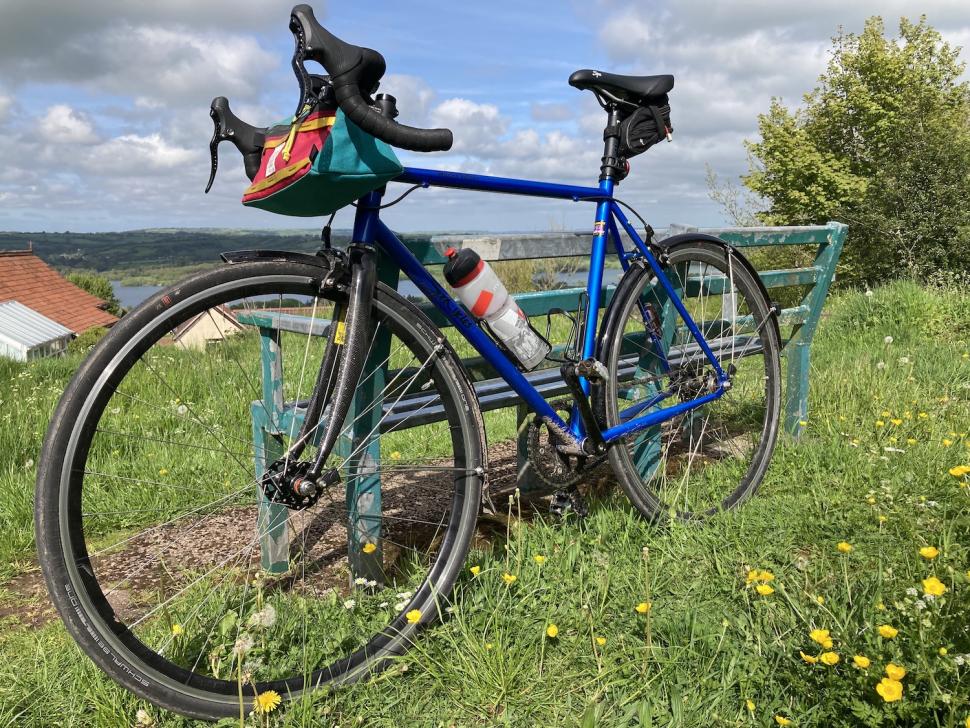
















































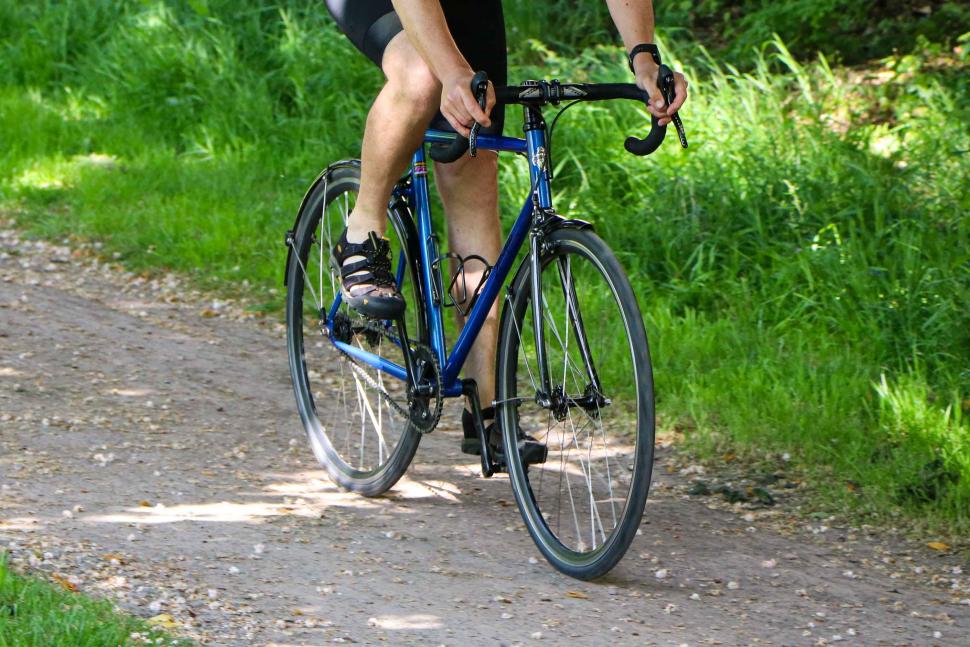
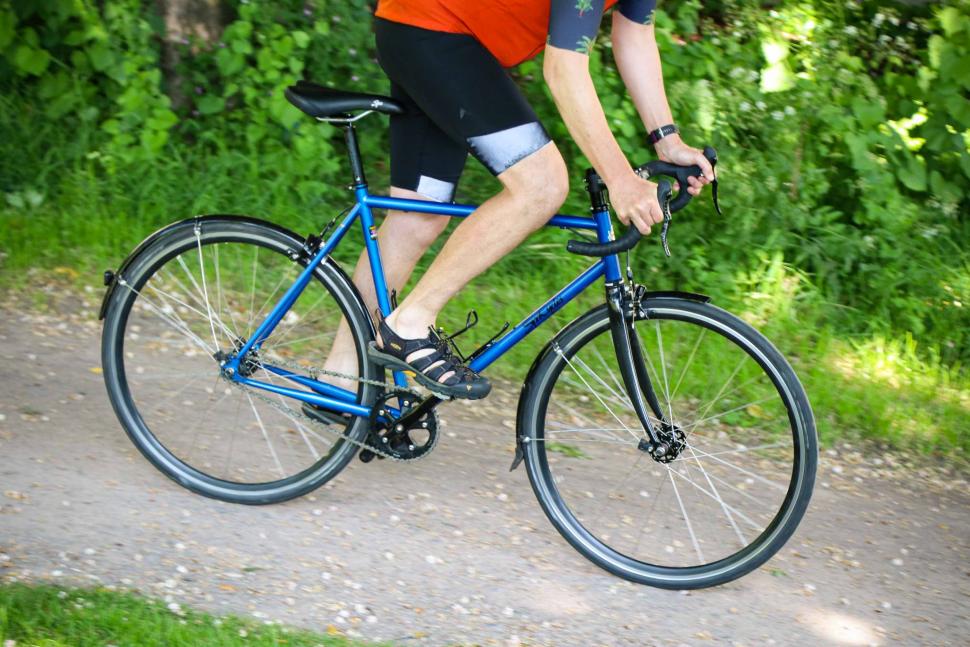
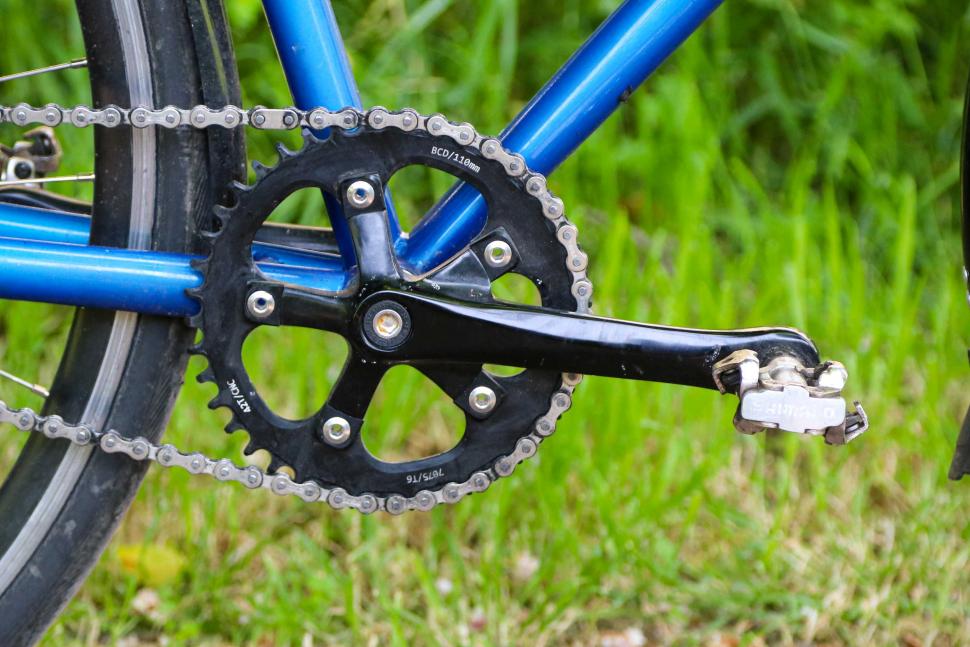



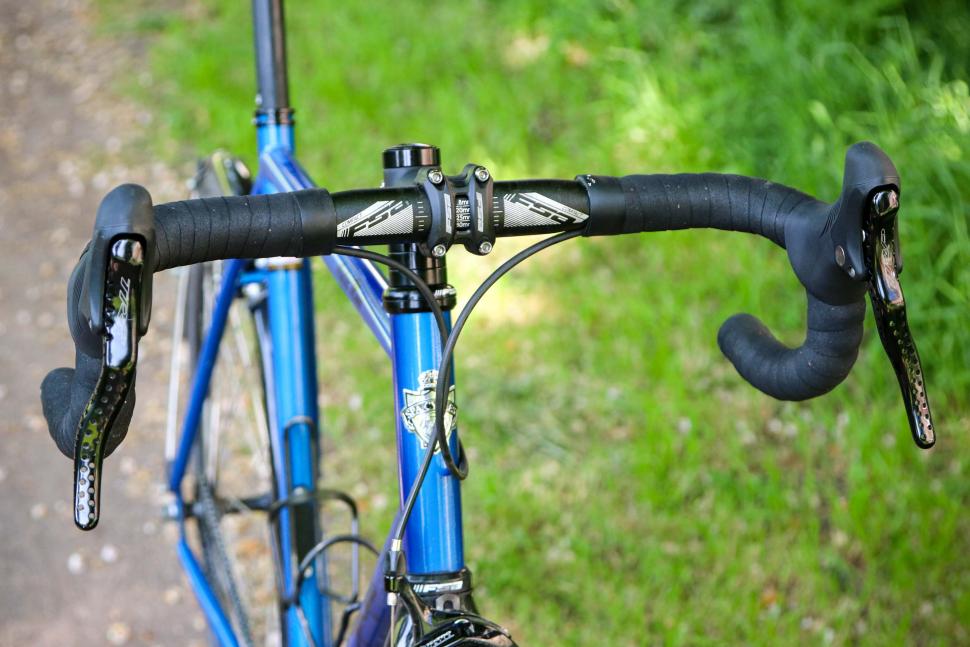





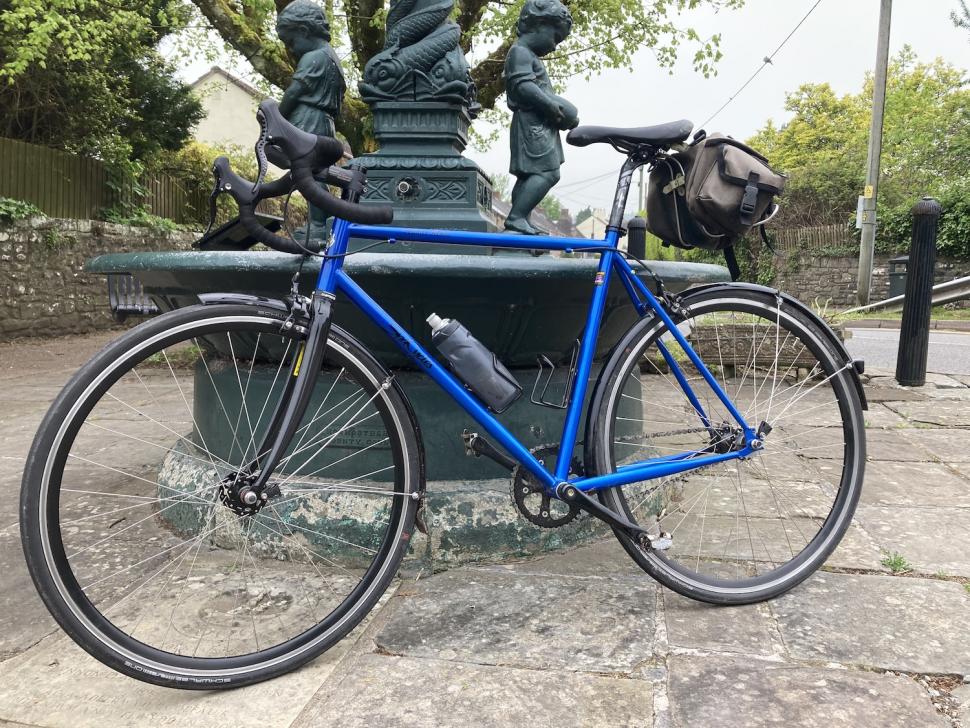

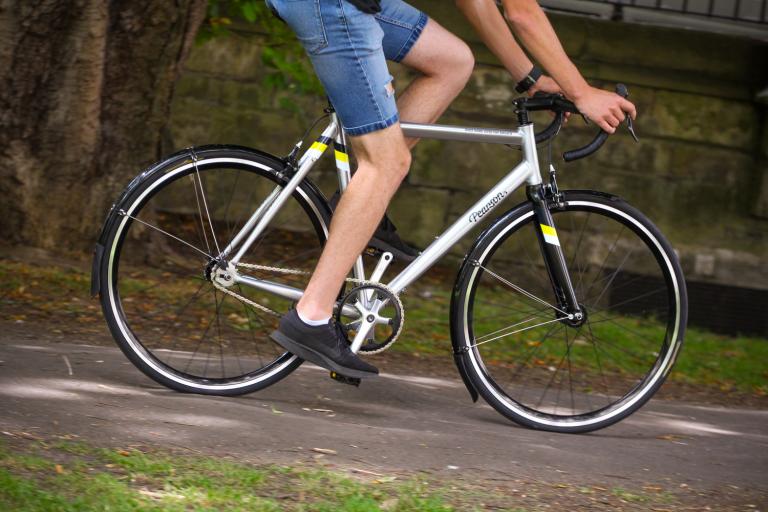
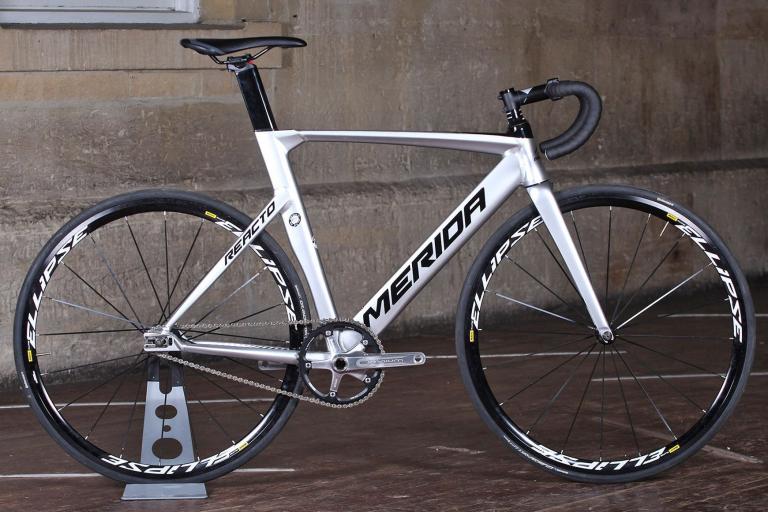
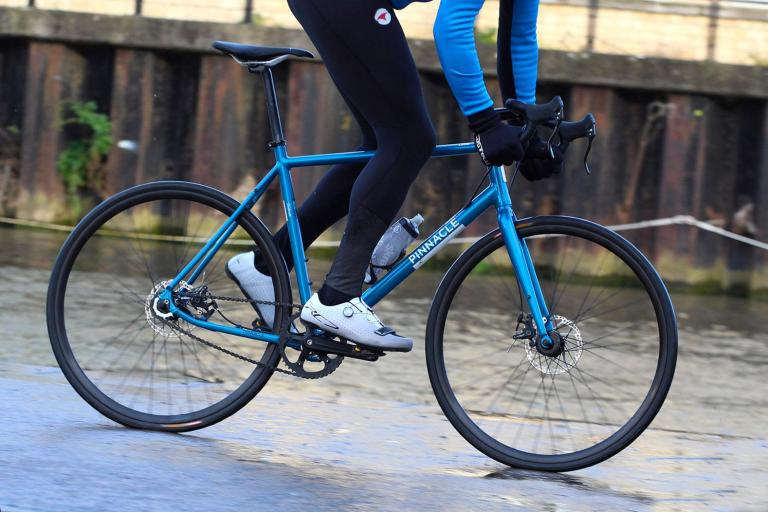

Add new comment
14 comments
We bikers are all weirdos but fixed touring is a special kind of weirdo I have little love or respect for.
Doing the ride for the comments instead of the joy of riding.
"wow man you got up this hill without gears".
Yes I fecked up my knees for two hours grinding up this hill then I will spin out on the descent and have little control.
Gears are an evolution of joy in cycling.
What on earth makes you think that people go fixed touring for the comments? I sincerely doubt that they care what other people think, especially people commenting on the internet.
42x16 will work well for gently rolling terrain. As mentioned, the bike is a little lighter - so you get a little bonus on weight. The efficiency of a fixed-gear also gives you a bonus, which becomes more and more significant with longer distance.
For long-distance touring over gentler terrain, fixed makes a lot of sense. Efficient. And very simple, with a thicker and stronger chain - lot less to go wrong than a delicate 10+ speed with lots of moving and honed-to-near-breaking-point parts.
I used to have a Kona Paddywagon which is very similar to the bike being reviewed and it was a brilliant long distance machine. Same gearing of 42/16 which I found was absolutely fine if the climb was in single figures, over 10% was a bit more taxing...
I did Dunwich Dynamo then onto Norwich a few times and the biggest issue with the gearing was keeping up with others on geared bikes on the gentle downhills!
I use 42x18 which works on steeper gradients. The development is 67 gear inches so 90rpm=16.7mph. Obviously that means getting used to doing 100-110rpm on the flat and approaching 30mph downhill means 150+ rpm. It is still very enjoyable to ride, especially when attacking hills.
Perhaps they just enjoy it?
Yes. Climbing gentle gradients (up to 5%) is actually easier on a fixed gear (providing you have picked the right ratio). If you build momentum into the climb, your bike will want to take you up. The inertia from the rear wheel will kick you forwards when you reach the deadspot on the pedal stroke allowing you to put the power down more efficiently, whereas on a freewheeled system you lose your momentum and need to push that little bit harder to get over the deadspot. Descending can be hair-raising. It takes some getting used to when you are used to freewheels, but generally I feather brakes to scrub speed whilst applying a little back pressure.
There is definitely a nuance to riding fixed, but I enjoy the challenge from time to time.
Agreed. Instead of messing about with gears it's about getting into a nice rhythm and riding up. It's really not much slower or more tiring than using gears.
Agreed on fixed being better for climbing - IF you're still within your gear. When you ride fixed, you'll get used to quite wide a range of cadence - so that 1 gear can cover quite a wide range of speeds. Assuming that, fixed gears actually shine uphill. I can understand why hillclimb TTers often went fixed in the past (and hard to understand why few seem to anymore).
My fixed - which has a big ring for speed on my flat commute - is easily my fastest bike on short punchy 2 to 3% uphills, 1 to 2 minute efforts.
I suppose this would also improve one's pedaling style as well, even when riding a non-fixie. Hence why so many road pros start out track riding....
We bikers are all weirdos, but you are a narrow minded, unpleasant weirdo.
I'm not a fixie rider myself, I have one singlespeed bike for my bike messenger shifts, but for all other things I ride (and like) geared bikes. But if someone else gets pleasure out of riding something else, why should that bother me? Recumbant, fixie, Penny Fartling, tandem, mono-cycle, whatever… I say good for them. If it's for the connected feel, for the sense of accomplishment, or even 'for the comments', who are you to judge? Like people who ride with Strava don't enjoy the likes and comments they get for a long or fast ride, or for a KOM.
That YOU don't see the fun in something, or don't agree with the reasoning behind it, doesn't make it stupid.
I say let everybody find their own joy in cycling.
Nit-picking I know, but 73 gear inches is not the distance the bike moves with one full turn of the pedals. It is the diameter of a wheel that would travel that distance in one revolution. The development (distance travelled by bike for each pedal revolution) would be 73 inches x pi = about 229 inches or 5.8m.
Now that's out of the way, +1 for Spa Cycles. I have a couple of sets of wheels built by them and they are great. Nice people too. And +10 for a fixie revival, it must be time!
I didnt know fixie audax was a thing. Chapeau you nutters!
Oh yes, people rode London Edinburgh London on fixed.
I suppose when the hills get so steep you have to walk anyway (pennines to and from St Johns Chapel), being fixed or geared doesn't make a difference.